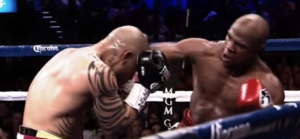Before I started training, I spent a considerable amount of time wondering ‘What kind of Martial Arts should I take?’. I knew I wanted to practice some form of martial art but when I started to look at what was available in my local area, I was almost overwhelmed by the shear number of different options available.
The choice included Brazilian Jiu Jitsu, Karate, Judo, Taekwondo, Aikido, Krav Maga and Tai Chi to name but a few.
If you’ve never trained in martial arts, the question of which one to study can be somewhat daunting. To help guide my decision, I compiled a list of essential key information for each I’ve included it below in the hope others might find it useful.
What kind of martial arts should I take?
Having carried out extensive research on each martial art, I scored them based on a number of variables:
Physicality
One of the key considerations for me was the degree of physicality involved in each martial art.
My day job consisted of working in an office and I was reluctant to participate in an activity which would be likely to result in a black eye or broken nose. I didn’t think my manager would have been too impressed!
It should be noted that any martial art comes with a risk of physical injury but obviously, with some, that risk is much higher.
At the same time, I wanted to use martial arts training as a way of keeping fit, so it had to be reasonably physically demanding in order to have the desired effect on my cardiovascular system. It was a question of finding the right balance.
I used a scoring system from 1-5, with 1 representing minimum level of physical demand (eg. Tai Chi) and 5 indicating extremely physically demanding eg. MMA
Most effective martial art in a real fight
Self Defense v Sport Orientated
A number of martial arts are focused on tournaments and competitions. They may have originally had their origins on the battlefield but, today, many of the more deadly moves have been removed to enable the martial art to be practised as a sport.
That’s not to say that “sport” martial arts won’t be of help during a self- defense scenario but it’s not their primary focus.
Initially, I used just one variable but after much consideration, I decided to break it into two. Some martial arts are heavily competition orientated but are also highly effective as a form of self defense eg. MMA.
Again, I’ve scored it from 1 -5, with five being the most effective and 0 the least.
Fighting focus
Many martial arts focus on different areas of fighting such as grappling, striking, kicking and throwing. A few, encompass all these different areas and can be viewed as complete systems.
I needed to choose whether I wanted to study a martial art that mainly focused on one of these areas or , indeed, choose one that was more generalized in nature.
I also had in mind the view that Geoff Thompson expressed when looking at this topic. He liked to think of fighting systems in terms of ranges.
The legs are the longest limbs of the body and therefore the practitioners that study martial arts that focus on kicking eg Taekwondo,, function best when they are in kicking distance from their opponent.
The next closest distance is the punching range. Boxers are most effective when they are in fist striking distance.
Closer still is the clinch that than leads in to some form of throw, such as those found in judo.
The closest range possible is when two opponents end up grappling.
Geoff’s view was that if you could get inside your opponents preferred fighting range you were more likely to win the confrontation.
For instance, a skilled boxer would, provided they were able to get close enough, beat a Taekwondo player. A judo player would defeat a boxer if they could close the range to be able to throw their opponent. A skilled wrestler would be able to submit a judo player, assuming both opponents ended up grappling.
Choosing a martial art based on body type
I also had to take into account my own physical build. Indeed, whilst it’s a huge generalisation, certain body types favour certain martial arts. For instance, many successful judo player have short, stocky builds giving them a low centre of gravity. This makes them harder to unbalance and throw.
Individuals with longer arms and legs have a natural advantage in the striking arts since they will have a longer reach than their opponent..
That’s not to say that you can’t be successful if your body type doesn’t match the martial art you’re practising. However, you’ll need to develop tactics and techniques to overcome your disadvantages.
Summary:
| Physicality | Self Defence | Sport Orientated | Fighting focus | |
| Taekwondo | 3 | 3 | 5 | Kicking |
| Muay Thai | 5 | 4 | 5 | Kicking & Punching |
| Karate | 2 | 2 | 3 | Kicking & Striking |
| Kung Fu | 2 | 2 | 2 | Kicking & Striking |
| Tai Chi | 1 | 1 | 1 | |
| Judo | 4 | 3 | 5 | Throwing |
| BJJ | 4 | 4 | 5 | Grappliing |
| MMA | 5 | 5 | 5 | All ranges |
| Boxing | 5 | 5 | 5 | Punching |
| Krav Maga | 3 | 5 | 1 | All ranges |
Taekwondo

Still from YouTube
Physicality 3
Taekwondo is certainly physically demanding from a flexibility and cardiovascular standpoint. It involves high kick combinations executed in rapid succession.
However, its practitioners where padded head and chest protectors making it relatively safe.Taekwondo is certainly physically demanding from a flexibility and cardiovascular standpoint. It involves high kick combinations executed in rapid succession.
However, its practitioners where padded head and chest protectors making it relatively safe.
Self Defense 3
Taekwondo incorporates a combination of Karate, Chinese martial arts and fighting styles indigenous to Korea. The fighting style primarily focuses on a huge arsenal of kicks. My own view is that this makes it less effective as a self defensive art. In my mind, many physical confrontations happen in crowded environments where there isn’t room enough to wind up powerful kicks. Imagine a fight breaking out in a bar or club; ir’ll be too crowded for you to pull off that high spinning head kick, Surrouning obstacles, be they bystanders or items of furniture, will hinder any attempt to operate at this long range.
Sport Orientated 5
It’s practiced as a sport and has been an Olympic event since the 2000 Sydney Games.
Find your local Taekwondo school here!
Back to table
Muay Thai
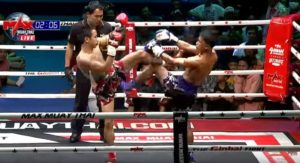
Still from YouTube
Physicality 5
Muay Thai is a truly brutal sport and not for the faint hearted. It incorporates elbows, knees, punches and kicks and all parts of the body, apart from the groin, are legitimate targets.
Given that kicks to the head are allowed, it arguable poses a greater risk to health than boxing.
It requires flexibility, and a huge amount of physical endurance. It also involves conditioning the body to both deliver and receive blows. Feet, shins, fists and elbows are turned into deadly weapons.
Related Article: Why is Muay Thai so dangerous?
Related Article: Is Muay Thai more dangerous than boxing?
Self Defense 4
Whilst it’s a sport, there’s little doubt that it would prove particularly effective in a self defence scenario. The elbow and clinches could be devastating against attackers who are in close range.
Practitioners of this sport would be used to physical confrontation. Indeed, it’s the adrenaline dump at the start of the confrontation that induces the flight or fight response. Unless you’ve have experienced this previously, it can come as a shock to the individual causing them to freeze: the last thing you want to do in a self defence situation.
Sport Orientated 5
This is the combat sport of Thailand and has now spread worldwide. Practitioners can spar and even compete should they will to do so.
Find your local Muay Thai gym here!
Back to table
Karate
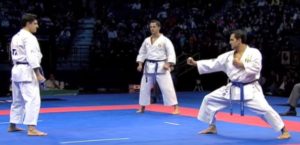
Still from YouTube
Physicality 2
The style consists of punches, kicks, elbow strikes and various open handed techniques, such as palm-heel strikes, knife-hands and spear-hands.
There are a number of styles of Karate. Shotokan karate, for example, is a more traditional style that is particularly concerned about perfection of technique. Moves are practiced repetitively in an effort to get the movement closer to the prescribed movement. It’s this focus on the perfect control that has given rise to karate being referred to as ‘moving zen’.
In this traditional style, there’s limited actual physical sparring. The fights that do occur are tightly controlled and techniques are supposed to be pulled short of actual contact.
In more sports orientated karate, there is actual contact but often chest and head guards are worn. In addition, whenever the fighters end up in a clinch, the referee will step in to seperate the two opponents.
Self Defense 2
For me, Karate has become too stylized and has strayed too far from its original combat roots. It’s easy to see how this could have happened. In order to train certain techniques to a large number of people, moves and techniques are broken down into their components and, what was once a free flowing combat style become systematised. Over time, too much emphasis is placed on style over substance.
An example of this can be seen in the kata that is practised by the karateka. These are a sequence of prescribed movements that incorporate kicks and punches and supposedly ‘secret’ moves (bunkai). The reality is that many of these movements have strayed so far from their original purpose that, from a self defence standpoint, they are practically worthless.
The lack of actual contact in many karate styles and minimal work at close quarters made me score karate fairly low in this category.
Sport Orientated 3
There are karate tournaments in which karateka compete in both sparring (kumite) and kata events. However, this is not how karate originally developed and it’s of course possible to practice karate without having to compete.
Find your local karate dojo here!
Back to table
Kung Fu

Still from YouTube
Physicality 2
There are many different styles of kung fu, each containing different blocking and striking techniques.
It’s a fairly safe martial art to practice and lessons consist of continually practicing certain techniques. Any actual sparring that does take place is tightly controlled and opponents are seperated should they end up in a clinch position. During training, full contact is not permitted.
Over time, continued practice can develop a good level of flexibility and stamina.
Self Defense 2
Kung fu as it is practiced today has strayed far from its original combat roots. It has become highly stylized and practice rarely consists of practical self defence techniques.
Sport Orientated 2
Kung fu competitions are relatively new and focus on the demonstration of set forms (predetermined sequences of movement). These can involve weapons such as the spear and sword. The moves are choreographed and participants are scored on their performance completing the set techniques.
Find your local kung fu school here!
Back to table
Tai Chi
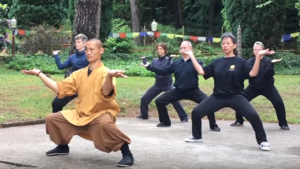
Still from YouTube
Tai chi is an ancient Chinese martial art that, today, is practiced as a graceful form of exercise. It involves performing a series of movements in a slow, focused manner and accompanied by deep breathing
Originally the various moves represented defensive and attacking techniques but this meaning has largely been lost.
Physicality 1
Tai Chi is a very gentle art with slow,precise movements. You are unlikely to gain any cardiovascular benefits but it is good for joint mobility and general flexibility.
Self Defense 1
Granted, Tai Chi has combat techniques hidden within its movements. However, these techniques are rarely performed. There is no sparring in Tai Chi.
Sport Orientated 1
Surprrisingly Tai Chi is practised as a sport in a form of a push hand competition. Two opponents stand opposite each other with the aim of tripping or pushing their opponent out of the ring.
Whilst there are Tai Chi competitions it’s really not the main focus of this martial art.
Find your local Tai Chi school here!
Back to table
Judo
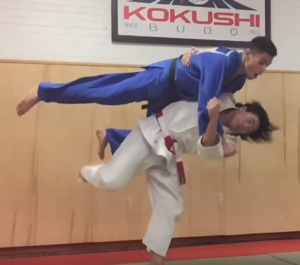
Still from YouTube
Physicality 4
Judo is a brutal sport. Trying to throw, grapple or pin an opponent who is trying to do the same to you is physically demanding. Regular practice will develop your cardiovascular endurance and strength in no time at all.
Whilst you will learn to break fall, being thrown can still be quite dangerous as it’s still possible to land incorrectlly and jar some part of your body.
Self Defense 3
The sport is typically practised at close range in the clinch in which the opponents are holding on to each others clothing. This is quite a common position to be in in a self defense scenario. In addition, because it’s practised as a sport where your opponent is actively trying to resist you, your technique has to finely honed to be effective.
One of the major drawbacks from a self defense perspective is that there are no actively practised strikes in judo. There are striking techniques in judo but these are incorporated in kata (choreographed patterns of movement). Viewed from this perspective, judo is an incomplete self defense system.
Sport Orientated 5
Judo has been an Olympic sport since 1964. The aim is to either throw or takedown an opponent to the ground, immobilize or otherwise subdue them with a pin, or force them to submit with a joint lock or a choke. Like boxing, Judo has different weight categories and contests are won on a point scoring basis.
Find your local judo club here!
Back to table
BJJ
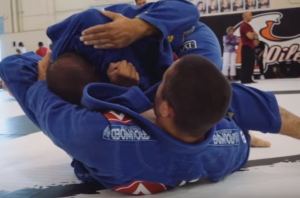
Still from YouTube
Physicality 4
BJJ is mainly a ground based, grappling sport where points are won by performing certain techniques on your opponent; these include chokes, strangle holds and joint locks.
Despite the brutal sounding nature of this sport, it is much safer than it sounds. BJJ players are taught to “tap” when they feel the technique taking effect. The “tap” is a signal to the opponent to instantly stop whatever move they are applying before any damage is done.
Self Defense 4
Many real life confrontations up with the combatants on the floor. Either one or both individuals trip or someone is thrown or pushed over.
The underlying ethos of the martial art is to use superior technique to overcome a stronger opponent. This is especially important for females as any confrontation is likely to end up on the ground and you will need to learn how to neutralise your attacker and escape.
However, this art does not involve any striking techniques and therefore is somewhat incomplete as a self defense system. In addition, from a self defense perspective the last place you want to end up is on the floor, particularly if you are confronted by multiple opponents. If you were taken down, it would be easy for a second attacher to kick and strike you whilst you are tied up with the other opponent.
Sport Orientated 5
BJJ competitions have exploded in popularity and are an excellent way for practitioners to determine the effectiveness of their technique. There are a wide range of weight categories allowing fighters to be fairly matched against each other.
Find your local BJJ school here!
Back to table
MMA

Still from YouTube
Physicality 5
Mixed Martial Arts is the hardest martial art there is. Joe Rogan describes it as “High level problem solving with dire physical consequences”. Kicks to the head, elbows and punches to the face are allowed. A look at any UFC fight will show you how violent these fights can be. Practically the only things that are not allowed are eye gouges and kicks to the groin.
That’s not to say that MMA training will be this physical but any fighter embarking in this sport should be aware of the high potential risk that is associated with this fighting style..
Self Defense 5
MMA, perhaps more than any other combat sport, almost replicates an actual confrontation scenario. Granted it’s only a one on one situation, whereas a street attack is likely to involve multiple assailants. However, a MMA fighter will gain experience of violence at close quarters and in time, will learn to control the emotions they experience and the techniques required to defend themselves.
Sport Orientated 5
There are numerous MMA competitions which typically consist of three, five minute rounds. Victory is determined by points, tap out or KO. They often take place in a fenced arena (like the UFC’s Octogan).
As I’ve mentioned , MMA competitions are not for the faint hearted.
Find your local MMA club here!
Back to table
Boxing
Still from YouTube
Physicality 5
A look at any televised boxing match will show you how brutal boxing can be. It’s not just the fights themselves but also the training that’s involved: hours hitting the punch bag and speed ball, skipping, running and sparring.
This training develops amazing physical endurance and strength. This is required in order to be able to withstand the barrage of punches you are subjected to in a sparring session. These can be directed to both your head and body.
Self Defense 5
Not only is the intense training regime good for preparing your body for any physical confrontation but it also conditions the mind to be able to cope with a violent attack.
In addition, a well trained boxer will not only be able to hit hard but also be able to dodge and block strikes that are aimed at them. Their physical endurance and speed will also enable them to run away from danger when required.
Sport Orientated 5
Boxing is primarily a sport and has been a part of the Olympics since 1904. Professional bouts are limited to a maximum of twelve rounds, most are fought over four, six, eight or ten rounds depending upon the experience of the boxers.
Find your local boxing club here!
Back to table
Krav Maga
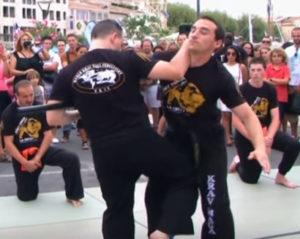
Still from YouTube
Physicality 3
Krav maga is an Israeli military self defence system. In many ways it’s a hybrid of a number of martial arts with techniques taken from judo, wrestling, boxing and karate. Training involved developing fighting strength and endurance. A typical session will involve the demonstration of a number of techniques (combatives). There is an emphasis on simulated attacks both by single and multiple adversaries.
The training can be tough but it is also highly controlled. Heavily padded headguards, gloves and body protection is used to minimise injury.
Self Defense 5
It has been designed purely for self defense and it’s the system used by the Israeli army. It’s effective.
Sport Orientated 1
Whilst there are a limited number of competitions emerging, this is not the focus of this martial art.
Find your local krav maga school here!
Back to table
Conclusion
For me, one of the issues with some martial arts is that they have become overly stylised. Training often involves the practice of choreographed techniques with a compliant opponent. They have become the epitome of “style over substance”.
In reality, any self defense situation will be highly chaotic and violent. Aside from Krav Maga, those martial arts with a sporting element are therefore likely to be more effective as their participants will compete against each other in order to win. This develops attacking and counter-attacking technique and skill.
Regardless of which martial art you choose, you should ensure that the gym or dojo provides high quality training and develops the right fighting attitude in its students.
I hope this guide has been useful in helping you answer the question of ‘What kind of martial arts should I take?’.
Back to table
Happy training!
Let me know if you agree with my scoring or if I’ve missed any martial arts out.
Related Articles:
What are the best tactics if you get in a fight?
Explore Martial Arts Styles: Your Guide
Joint Problems? Try Gentle Martial Arts

